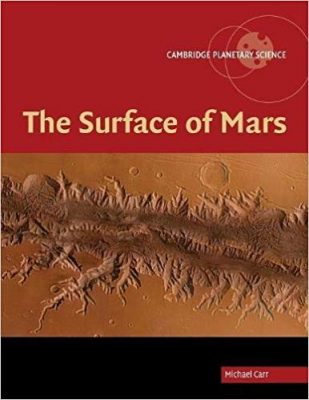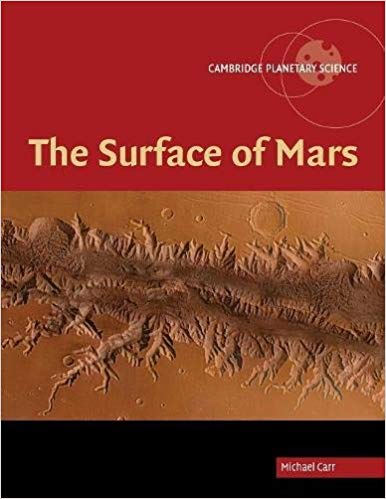 This book is part of the Cambridge Planetary Science Series, whose editors are F. Bagenal, F. Nimmo, C. Murray, D. Jewitt, R. Lorenz, and S. Russell.
This book is part of the Cambridge Planetary Science Series, whose editors are F. Bagenal, F. Nimmo, C. Murray, D. Jewitt, R. Lorenz, and S. Russell.
Author: Michael Carr
Publisher: Cambridge University Press – 307 pages
Book Review by: Sonu Chandiram
The Mars Global Surveyor, Mars Odyssey, Mars Express, and two Mars Rover missions have greatly enabled the enormous expansion of knowledge about one of our closer planetary neighbors. This book is described as a “systematic summary of what we have learned about the geological evolution of Mars as a result of these missions, and builds on the themes of the author’s previous book on this topic.”
Mars’ geology has features similar to those of the Earth, but they are huge in comparison – about 10 times larger – including canyons, river channels, and volcanoes. This book describes those features, and provides summaries on how, when, and under what circumstances they formed.
This book also shows how Earth and Mars differ, and provides explanations on the question of why they evolved differently. It contains over 200 illustrations, and at the end of the book is provided a rich, detailed reference list of sources of information on this planet.
We provide you a brief overview of what you will find in this book with this enumeration of chapter titles:
- Overview
- Impact Craters
- Volcanism
- Global Structure and Tectonics
- Canyons
- Channels, Valleys, and Gullies
- Lakes and Oceans
- Ice
- Wind
- Poles
- The View from the Surface
- Climate Change
- Implications for Life
- Summary
Published in 2006, Michael Carr begins his book by listing 23 Mars missions of the United States and USSR, and of Europe, from 1964 until 2006. There were 14 launched by the U.S, eight by the USSR and one by Europe.
The list provides the outcomes of each – which ones flew by, went into orbit and took and sent images, landed, or crash landed. In sum, the successes were more than the failures, so we gained a lot of insight and understanding about this planet in the 42-year period.
The missions that flew by or went into orbit have provided every greater (quantity) and clearer (quality) of images. Those that landed and traversed the planet have scrutinized and analyzed the elements of its surface including meteorites, rocks, and soil.
The images in the book are not in color but in grayscale. However they provide a lot of detail of various features such as: the atmosphere and wind on the planet, its canyons, craters, deposits, drifts, dunes, dust storms, gullies, ice formations, lakes, landslides, oceans, plains, river channels, valleys, volcanoes, and other elements of its physiography.
Conditions are very hostile on Mares to support life, but there is a possibility that at some time in the past, life in some form existed on that planet. Upon closer examination, some form of life may exist at the present time, the author writes.
He asks in chapter 13 – Implications for Life – Did some form of life start on Mars also (as it did on Earth)? If it did start, did it survive to the present day in niches protected from the current hostile surface conditions?
Dr. Carr points out that this chapter “merely gives an overview of some of the issues” pertaining to life on Mars, and this topic is outside his area of expertise. But he nevertheless included it in the book “because the search for life and its origins is the main thrust of the Mars exploration program and because the search has such broad philosophical implications.”
Author:
Michael Carr is a Geologist Emeritus at the U.S. Geological Survey, and has over 40 years of experience in planetary science research. In the early 1970s Dr. Carr was a member of the Mariner 9 team and leader of the Viking Orbiter Imaging team.
He was co-investigator on the Mars Global Surveyor, the Mars Exploration Rovers, and the High Resolution Stereo Camera on Mars Express. He is a Fellow of the Geological Society of America, the American Geophysical Union, and the American Association for the Advance of Science.
He was awarded the 1994 National Air and Space Museum Lifetime Achievement Award for his work on Mars. He is also the author of The Surface of Mars (1981) and Water on Mars (1996).







